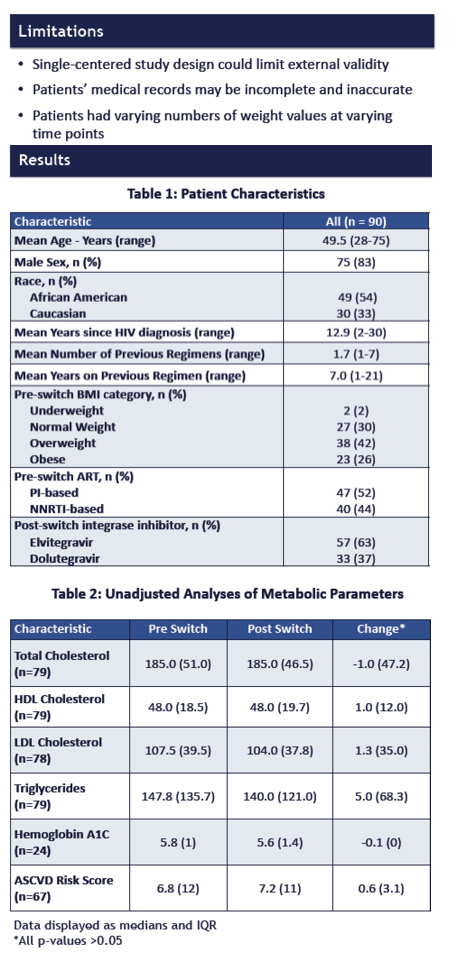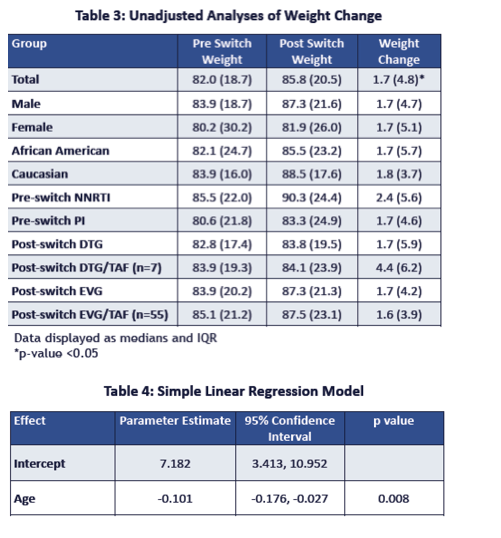 |
 |
 |
| |
Weight Rises--But Lipids and HbA1c Don't--After Switch to Integrase Drugs
|
| |
| |
IDWeek, October 2-6, 2019, Washington, DC
Mark Mascolini
Weight rose, sometimes substantially, in a single-center US analysis of people switching from a nonnucleoside (NNRTI) or a protease inhibitor (PI) to an integrase inhibitor [1]. But neither lipids nor hemoglobin A1c, a diabetes marker, surged in these people, and only age emerged as a weight-change predictor: older age protected against weight gain.
Several studies document unwanted weight gain when starting or switching to an integrase inhibitor [2,3], including other studies presented at IDWeek 2019 [4,5]. But clinical consequences of adding weight with integrase inhibitors remain uncertain. And little research addresses metabolic changes--like shifts in lipids and HbA1c--in people trading a suppressive NNRTI or PI regimen for an integrase inhibitor combination.
To address these issues, researchers at Thomas Jefferson University in Philadelphia conducted this chart review of people taking antiretroviral therapy (ART) at their center from May 2015 to December 2017. Everyone had viral suppression with an NNRTI or a PI for at least 1 year before switching to an integrase inhibitor. The Jefferson team gathered data on weight, lipids, and HbA1c in the year before and the 18 months after the switch. They used simple linear regression to identify predictors of weight gain.
The study group included 90 people, 75 of them (83%) men, averaging 49.5 years in age (range 28 to 75). Forty-nine people (54%) were black and 30 (33%) white. They had taken an average 1.7 ART regimens and averaged 7 years on their previous combination. At the switch, 2% of participants were underweight, 30% normal weight, 42% overweight, and 26% obese. Slightly more people switched from a PI than from an NNRTI. While 57 (63%) started elvitegravir, 33 (37%) started dolutegravir.
Unadjusted analysis showed no substantial change from before to after the switch in total cholesterol, "good" high-density lipoprotein cholesterol, "bad" low-density lipoprotein cholesterol, triglycerides, HbA1c, or atherosclerotic cardiovascular disease risk score. Weight rose by a median 1.7 kg after the switch to an integrase inhibitor, a significant change (P < 0.05). This gain did not vary much between men and women or between blacks and whites. But the 7 people switching to a dolutegravir/tenofovir alafenamide (TAF) regimen gained more weight (median 4.4 kg) than the 55 switching to elvitegravir/TAF (1.6 kg) or to any dolutegravir regimen (1.7 kg) or any elvitegravir regimen (1.7 kg). Overall, 26% of participants gained more than 4.5 kg.
Simple linear regression pinpointed only one predictor of weight gain: older age protected against weight gain (parameter estimate -0.101, 95% confidence interval -0.176 to -0.027, P = 0.008). Another IDWeek study, reviewed separately by NATAP [4], also found a lower risk of weight gain with integrase inhibitors in older people: This 260-person Washington, DC study found that older age when switching to an integrase inhibitor correlated with lower weight gain (rho = -0.14, P = 0.048).
As the Thomas Jefferson team observed, mechanisms and predictors of weight gain with integrase inhibitors clearly require more study.
References
1. Zimmerman M, DeSimone J, Schafer JJ. Exploring the prevalence and characteristics of weight gain and other metabolic changes in patients with HIV infection switching to integrase inhibitor containing ART. IDWeek, October 2-6, 2019, Washington, DC. Abstract 981.
2. Palella F Jr, Rayeed N, Ward D, et al. Weight gain among virally suppressed persons who switch to INSTI-based ART. Conference on Retroviruses and Opportunistic Infections. March 4-7, 2019. Seattle. Abstract 674. http://www.natap.org/2019/CROI/croi_56.htm
3. Menard A, Meddeb L, Tissot-Dupont H, et al. Dolutegravir and weight gain: an unexpected bothering side effect? AIDS. 2017;31:1499-5000.
4. Saber S, Bernstein AB, Sparks AD, Siegel MO. Weight change associated with antiretroviral therapy switch to integrase strand transfer inhibitor-based regimens. IDWeek, October 2-6, 2019, Washington, DC. Abstract 334.
5. Kline D, Daniels C, Xu X, et al. Antiretroviral therapy anchor-based trends in body mass index following treatment initiation among military personnel with HIV. IDWeek, October 2-6, 2019, Washington, DC. Abstract 335.



|
| |
|
 |
 |
|
|